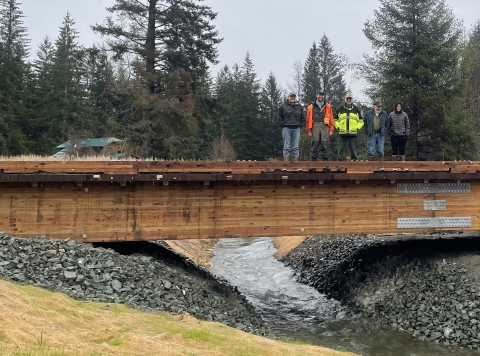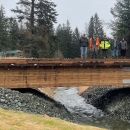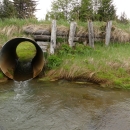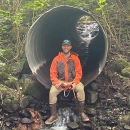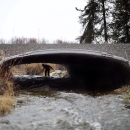States
AlaskaThe U.S. Fish and Wildlife Service, City of Gustavus, Trout Unlimited, Alaska Sustainable Salmon Fund and National Fish and Wildlife Foundation have been working together for many years to restore aquatic connectivity and fish passage fish passage
Fish passage is the ability of fish or other aquatic species to move freely throughout their life to find food, reproduce, and complete their natural migration cycles. Millions of barriers to fish passage across the country are fragmenting habitat and leading to species declines. The U.S. Fish and Wildlife Service's National Fish Passage Program is working to reconnect watersheds to benefit both wildlife and people.
Learn more about fish passage in Gustavus via a series of culvert-to-bridge and other fish passage projects. An undersized culvert on Harry Hall Creek at Grandpa's Farm Road is the final piece of the puzzle. Isostatic rebound, where land rises after heavy ice sheets retreat, is causing a too-small culvert to become more “perched” above the creek over time. In addition to salmon, Dolly Varden and coastal cutthroat trout use this creek.
Bipartisan Infrastructure Law Bipartisan Infrastructure Law
The Bipartisan Infrastructure Law (BIL) is a once-in-a-generation investment in the nation’s infrastructure and economic competitiveness. We were directly appropriated $455 million over five years in BIL funds for programs related to the President’s America the Beautiful initiative.
Learn more about Bipartisan Infrastructure Law funding will allow for the last culvert impeding fish passage to be replaced with a timber bridge. This completes the effort to reconnect the Mountain View and Flats Creek drainages to provide unimpeded access to six miles of rearing habitat for juvenile Coho salmon—a very significant amount of habitat in an area of Alaska with tight topography and generally shorter river systems. It also fixes the traffic safety issue which came along with a narrow road with no guard rails, unstable banks, and a failing embankment.
Quick Facts:
| Project Status | Complete |
| Location | AK, Hoonah-Angoon Census Area |
| NFPP Project Funding | $600,000 |
| Restoration Techniques | Culvert Replacement |
| Accomplishments | 6 Stream Miles Reconnected |
| Project Partner Lead | City of Gustavus |
| Primary Species Benefited | Coho Salmon |
The National Fish Passage Program combines technical expertise with a track record of success.
Implemented primarily through the Service's Fish and Wildlife Conservation Offices, the National Fish Passage Program provides financial and technical assistance to partners across the country. Since 1999, the program has worked with over 2,000 local communities, Tribes, and private landowners to remove or bypass over 3,400 barriers to fish passage and reopen access to over 61,000 miles of upstream habitat for fish and other animals. Staff have expertise in fish migration and biology as well as financial, engineering, and planning assistance to communities, Tribes, and landowners to help them remove barriers and restore rivers for the benefit both fish and people.
Fish passage project proposals can be initiated by any individual, organization, government, or agency. However, proposals must be submitted and completed in cooperation with a Fish and Wildlife Conservation Office. (Please note that fish passage projects being used for federal or state compensatory mitigation or required by existing federal or state regulatory programs are not eligible for funding through the National Fish Passage Program.)
CONTACT A FISH PASSAGE COORDINATOR IN YOUR AREA TO GET STARTED.


